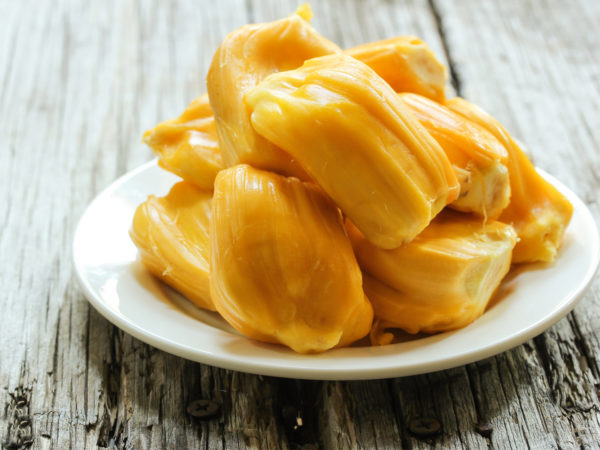Why Eat Jackfruit?
I never heard of jackfruit until recently. What is it? And should I add it to my diet?
Andrew Weil, M.D. | October 22, 2018

Jackfruit comes from a large tropical tree in the fig family (Artocarpus heterophyllus) native to southwest India. It is the largest of all tree-born fruits: from eight inches to three feet long, six to 20 inches wide and weighing from 10 to 110 pounds. The rind is green or yellow when ripe.
Jackfruit is cultivated throughout India, Sri Lanka, Myanmar and elsewhere in Asia and in parts of Africa including Kenya and Uganda. In recent years, it has become increasingly popular in the U.S. as a meat substitute for vegans or vegetarians because the pulp is similar in texture to pulled meat. Jackfruit has 155 calories per cup and provides dietary fiber, iron, potassium, calcium, vitamin B6 and vitamin C. On its own, however, it won’t give you much protein – only about three grams per cup. For that reason, if you’re planning to use it as a meat substitute, you will need to add other sources of vegetable protein such as lentils or chickpeas or whole soy to your meals.
You may be able to find ripe, uncut jackfruit during the summer at Asian markets. The fruit has a strong odor similar to that of decayed onions, but once you cut into it, the pulp smells and tastes of mango, apples, pineapple and banana. Be aware that the ripe fruit is somewhat laxative and can cause diarrhea if you eat too much. The raw seeds are indigestible, but you can eat them after roasting or boiling.
Left at room temperature, ripe jackfruit turns brown and deteriorates quickly but according to information from Purdue University, can be kept in the refrigerator for three to six weeks at 52 to 55 degrees Fahrenheit and a relative humidity of 85 to 95 percent.
Jackfruit has become so popular in the U.S. in recent years that you now can buy it freeze dried, packaged, canned or in pouches; flour made from the dried fruit is also available, along with jackfruit ice cream, juice and chips.
Commercially packaged jackfruit can be used in chilis, stews, tacos and burritos and as a substitute for pulled pork in sandwiches. You can pickle the flesh and use it as you would other pickled vegetables or boil it and add it to curries or salads or serve it as a side dish.
Perhaps the most important use of jackfruit in the years ahead may be to help replace wheat, corn and other staple crops, which are becoming less and less available in southeast Asia due to climate change (especially rising temperatures and less rain). Jackfruit is easy to grow, is drought resistant and able to survive pests, diseases and high temperatures.
I’ve enjoyed ripe, fresh jackfruit and consider it worth trying as a meat substitute – for the texture, at least – if you follow a vegan or vegetarian diet.
Andrew Weil, M.D.
Source:
Julia F. Morton, “Jackfruit.” Purdue University, hort.purdue.edu/newcrop/morton/jackfruit_ars.html












